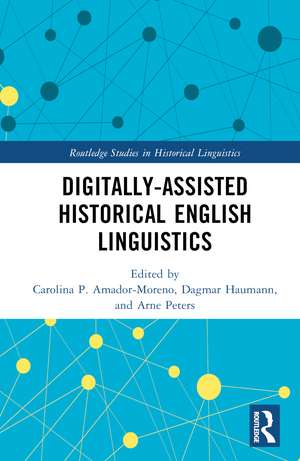Digitally-assisted Historical English Linguistics: Routledge Studies in Historical Linguistics
Editat de Carolina P. Amador-Moreno, Dagmar Haumann, Arne Petersen Limba Engleză Hardback – 22 dec 2023
With a clear focus on English, chapters in the volume showcase a broad range of digital methods and approaches that can contribute to advancing the study of historical linguistics. Visualization tools and corpus-linguistic techniques are part of the methodologies included in the volume. The chapters present empirically based research and discuss theoretical aspects that emphasize how digitalization is changing our analysis of different domains of language, going from phonology to specific grammatical/morphosyntactic and lexical features, to discourse-related issues more broadly.
This book will be of interest to scholars of the history of the English language, historical linguistics, corpus linguistics, and digital humanities.
Preț: 1005.67 lei
Preț vechi: 1226.42 lei
-18% Nou
Puncte Express: 1509
Preț estimativ în valută:
192.43€ • 201.46$ • 159.23£
192.43€ • 201.46$ • 159.23£
Carte tipărită la comandă
Livrare economică 07-21 aprilie
Preluare comenzi: 021 569.72.76
Specificații
ISBN-13: 9781032418995
ISBN-10: 1032418990
Pagini: 326
Ilustrații: 32 Tables, black and white; 15 Line drawings, black and white; 1 Halftones, black and white; 16 Illustrations, black and white
Dimensiuni: 152 x 229 x 19 mm
Greutate: 0.61 kg
Ediția:1
Editura: Taylor & Francis
Colecția Routledge
Seria Routledge Studies in Historical Linguistics
Locul publicării:Oxford, United Kingdom
ISBN-10: 1032418990
Pagini: 326
Ilustrații: 32 Tables, black and white; 15 Line drawings, black and white; 1 Halftones, black and white; 16 Illustrations, black and white
Dimensiuni: 152 x 229 x 19 mm
Greutate: 0.61 kg
Ediția:1
Editura: Taylor & Francis
Colecția Routledge
Seria Routledge Studies in Historical Linguistics
Locul publicării:Oxford, United Kingdom
Public țintă
PostgraduateCuprins
Prologue – 0. Digitally-assisted historical English linguistics: Perspectives and explorations Carolina P. Amador-Moreno, Dagmar Haumann, and Arne Peters, Section 1 – New methods for new questions in historical linguistics, 1. Determining the impact of education and socioeconomic status on linguistic choices in the Corpus of Irish English Correspondence Carolina P. Amador-Moreno and Karen P. Corrigan, 2. “I hope that a correspondence may still be kept up between us”: Exploring conversational dynamics through the lens of (im)politeness studies in CORIECOR David Sotoca-Fernández and Nancy E. Ávila-Ledesma, 3. Traditional data sets and the question of community bilingualism: The case of perfects and further vernacular features in Irish English Patricia Ronan, 4. When NLP meets Corpus Linguistics - A Computational Approach to Analysing the Corpus of Oz Early English Martin Schweinberger, Section 2 – Old data in the new digital age, 5.“His eye went neuer off of hir” – the development of the complex preposition off of from Middle English onwards, Jerzy Nykiel, 6. Pronouns of address in the history of Irish English Raymond Hickey, 7. Seriously, where do illocutionary adverbs come from? – a corpus-based assessment of the main hypotheses Dagmar Haumann and Kristin Killie, Section 3 – Investigating language contact through new technologies, 8. Complementiser deletion in that-clauses from Old to Late Modern English: A long-term diachronic corpus-based study Kristian A. Rusten, 9. Lexical evidence for the contact between Irish and Old Norse in contemporary uses of Modern Irish, Norwegian and Irish English Arne Peters and Marion Schulte, 10. Sorry mine tusen skrivefeil! Using digital language resources to assess the phrasemic and syntactic integration of the borrowed apology marker sorry Gisle Andersen Section 4 – Investigating dialect in the new digital age, 11. “[…] and the Brogue their was good fun that night in Uncle James” – A case study on a late 19th-century Ulster family network Dania Jovanna Bonness, 12. “[T]he largest mountan in nort america:” Evidence of “Southern” Irish English consonants in Ulster before 1900 in the Corpus of Irish English Correspondence Persijn M. de Rijke, 13. A corpus of traditional south-west Tyrone English Warren Maguire, 14. Epilogue - From Grimm to Ngrams: English historical linguistics in the digital age Kristian A. Rusten, Index
Notă biografică
Carolina P. Amador-Moreno is Professor of English Linguistics. She is currently based at the University of Extremadura, Spain. At the time of putting this book together, she was Professor of English Linguistics at the University of Bergen, Norway. Her research interests center on the English spoken in Ireland and include historical linguistics, stylistics, corpus linguistics, sociolinguistics, and pragmatics
Dagmar Haumann is Professor of English Linguistics at the University of Bergen, Norway. Her main research interests lie in synchronic and diachronic syntax, especially in the structural integration and licensing of modifiers in verbal and nominal projections, as well as in the development of speaker-oriented adverbs in English.
Arne Peters is Professor of Anthropological Linguistics/Cultural Linguistics at the University of Bremen, Germany. His cognitive sociolinguistic and cultural linguistic work focuses on lexical, morphosyntactic, and pragmatic manifestations of sociocultural cognition in L1 and L2 varieties of English worldwide, most notably the ones spoken in Ireland and South Africa.
Dagmar Haumann is Professor of English Linguistics at the University of Bergen, Norway. Her main research interests lie in synchronic and diachronic syntax, especially in the structural integration and licensing of modifiers in verbal and nominal projections, as well as in the development of speaker-oriented adverbs in English.
Arne Peters is Professor of Anthropological Linguistics/Cultural Linguistics at the University of Bremen, Germany. His cognitive sociolinguistic and cultural linguistic work focuses on lexical, morphosyntactic, and pragmatic manifestations of sociocultural cognition in L1 and L2 varieties of English worldwide, most notably the ones spoken in Ireland and South Africa.
Descriere
This collection features different perspectives on how digital tools are changing our understanding of language varieties, language contact, sociolinguistics, pragmatics and dialectology through the lens of different historical contexts.





